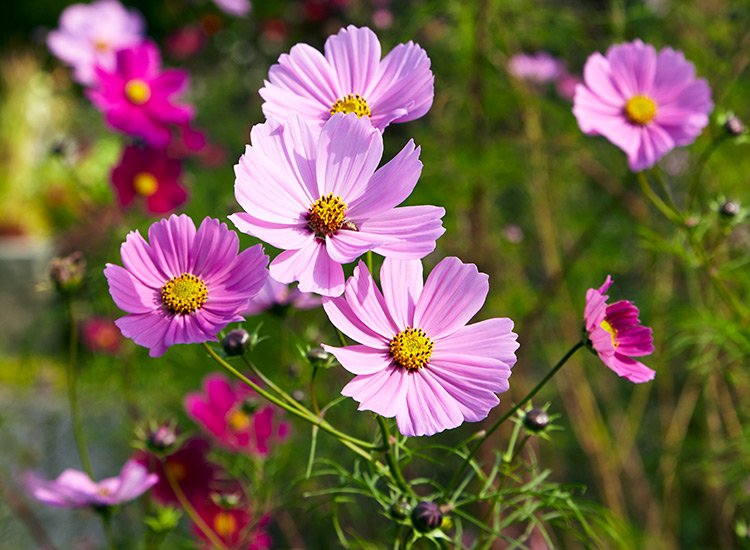Cosmos Flower specifications
- Scientific name : Cosmos
- Common Name : Cosmos, Mexican aster, cut-leaf cosmos
- Botanical Name : Cosmos sulphureus, Cosmos bipinnatus
- Order : Asterales
- Family : Asteraceae
- Subfamily : Asteroideae
- Tribe : Coreopsideae
- Genus : Cosmos
- Native : Northern South America, Central America, and southern North America
Cosmos flower are herbaceous perennial plants or annual plants growing 0.3–2 m (1 ft 0 in – 6 ft 7 in) tall. The leaves are simple, pinnate, or bipinnate, and arranged in opposite pairs. The flowers are produced in a capitulum with a ring of broad ray florets and a center of disc florets; flower color is very variable between the different species.
The genus includes several ornamental plants popular in gardens. Numerous hybrids and cultivars have been selected and named. The cosmos flower is native to Mexico and Central America. The cosmos flower is an annual and there are perennial varieties and it has a height of 60 to 90 cm.
read more : Everything about hydrangea flower : How to Plant & care for them

The flowers of this plant are in different colors of yellow, orange and red, which show a rainbow of colors. Cosmos flowers are able to bloom from spring to the beginning of the cold season.There is a type of cosmos flower that is hybrid and flowers earlier than other types of cosmos flowers and its flowering continues until frost.
The height of the cosmos flower reaches between 30 and 150 cm depending on its type. The seeds of this plant are sown at the base of the plant every year and turn green on their own, so with one planting of this plant, it is possible to have several years of this plant in the same place.
The cosmos is resistant to heat and disasters and is therefore able to grow in times of drought and survive in harsh conditions in urban gardens and wild fields. With sunny areas in every garden, these adaptive plants can be planted in pots or on the ground.
read more : Everything about lavender flower : How to plant & care for them
Cosmos flower species
- Cosmos atrosanguineus (Hook.) Voss
- Cosmos bipinnatus Cav.
- Cosmos carvifolius Benth.
- Cosmos caudatus Kunth
- Cosmos concolor Sherff
- Cosmos crithmifolius Kunth
- Cosmos dahlioides
- Cosmos deficiens (Sherff) Melchert
- Cosmos herzogii Sherff
- Cosmos intercedens Sherff
- Cosmos jaliscensis Sherff
- Cosmos juxtlahuacensis Panero & Villaseñor
- Cosmos landii Sherff
- Cosmos linearifolius (Sch.Bip.) Hemsl.
- Cosmos longipetiolatus Melchert
- Cosmos mattfeldii Sherff
- Cosmos mcvaughii Sherff
- Cosmos microcephalus Sherff
- Cosmos modestus Sherff
- Cosmos montanus Sherff
- Cosmos nelsonii B.L.Rob. & Fernald
- Cosmos nitidus Paray
- Cosmos ochroleucoflorus Melchert
- Cosmos pacificus Melchert
- Cosmos palmeri B.L.Rob.
- Cosmos parviflorus (Jacq.) Pers.
- Cosmos peucedanifolius Wedd.
- Cosmos pringlei B.L.Rob. & Fernald
- Cosmos purpurens Sherff
- Cosmos purpureus (DC.) Benth. & Hook.f. ex Hemsl.
- Cosmos scabiosoides Kunth
- Cosmos schaffneri Sherff
- Cosmos sessilis Sherff
- Cosmos sherffii Melchert
- Cosmos steenisiae Veldkamp
- Cosmos sulphureus Cav
read more : Everything about aster flower : How to Plant & care for them
Best time for planting cosmos flower
Late winter and early spring are the best times to plant cosmos flowers.
How to plant a cosmos flower
- Direct sowing of seeds
- Cultivation of seedlings
Iran dried cosmos flower
Cosmos flower is one of Iran’s export goods and has provided a great opportunity for Iranian traders to bring a lot of currency to the country by exporting dried cosmos flower . Both types of cosmos flower products can be exported either as fresh cut flowers or as dried flowers because each has its own customer.
The export of dried cosmos flower has provided a great opportunity for wholesalers and exporters of dried cosmos flower and other plants to make significant profits.
read more : Drying natural flowers | Introducing 8 wonderful ways to dry flowers
How to Care for Cosmos flower
- In order to prolong flowering, you should deadhead the plants (prune off dead/faded flowers). This speeds up flower development and aids branching.
- Because some of these plants can grow really tall, staking may be necessary. Offer them protection from strong winds, encourage balanced branching by pinching out (aka pruning) central shoots or stem tips, or stake them. Growing them against a fence can also provide the necessary support.
- Water regularly until plants are established or if it is unusually dry. Make sure you don’t over-water cosmos; over-watering and over-fertilization can lead to plants with fewer flowers. Cosmos can tolerate dry soil, even in a hot, arid, sunbaked spot.
- Cosmos beds may become weedy due to the fact that they self-seed, so remember to remove flowers before they go to seed or to thin seedlings in the spring.
Propagating cosmos flower
Cosmos plants readily self-seed. It’s best to propagate these plants after the threat of frost is gone. Although sowing seeds is the best and easiest way to propagate this plant, you can also propagate via stem cutting. When you take stem trimmings, it stimulates more leaf and flower growth. Besides seed, stem cutting is the best way to propagate this plant. Here’s how you do it:
You’ll need sterile pruning shears or scissors and a pot of sterile, well-draining potting soil.
Fill a small 3-inch container with moistened potting soil. Using a pencil tip, push straight down in the soil about 1 to 2 inches deep, making a shallow hole.
Look for a cosmos shoot that has 3 to 5 leaf nodes on the stem. Cut under the last leaf node. At the last leaf node, carefully cut off the leaves, leaving the node intact for new growth.
Bury the cut tip of the stem in the pencil-made hole. Make sure that the last leaf node is above the soil line. Push down the soil around the stem, compacting the soil to keep the stem upright and in place.
Water generously and keep moist. You should notice new leaf growth within three weeks. If you do, you can gently pull the root ball out of the container, Transplant the root ball to its new location.
read more : Everything about sea lavender flower : How to Plant & care for them
How to grow cosmos from seeds
Start seeds indoors, four to six weeks before the last frost. Or if you can sow cosmos outdoors directly in the garden well after the threat of frost is gone. Cosmos grow very quickly but can be killed by a late frost, so don’t rush it. They typically germinate in 7 to 21 days at 75 degrees Fahrenheit, followed by flowering in about 50 to 60 days.
Loosen the soil to a depth of 8 inches. Plant the seeds and cover them with 1/4 inch of fine soil. Seed packets usually recommend precise spacing, such as at 2-foot intervals, or you can scatter the seeds and let the plants support each other as they grow. You can always thin them out later, moving the extra plants to another part of the garden.
How to get cosmos to bloom
Cosmos plants need full sun to bloom. Even the hint of shade, can restrict flowering. Also, to encourage more blooms, you need to deadhead the old blooms. For faster blooms, prune between the main stem and a leaf. The lower you cut in the stem, the longer it takes to grow more flowers.
read more : Everything about Scorpion grasses : How to Plant & care for them
Recommended Varieties
- ‘Picotee’ have pretty white flowers with a crimson border around the edge of the flower (some are also flecked in crimson).
- ‘Sea Shells’ have white, pink, or red tube-shaped petals.
- ‘Purity’ is a beautiful, classic, white flower that looks spectacular growing against the dark-maroon
- ‘Niger’ hollyhock or purple basil.
- ‘Cosmos Sonata Series’ looks especially good with Bells of Ireland.
- ‘Chocolate’ cosmos adds distinction to a white campanula, dianthus, or ‘Moonshine’ achillea.
- Tall cosmos are best for the back of the garden and filling in mixed borders among perennials such as foxgloves, phlox, delphiniums, and daisies, as well as annuals such as poppies, cleome, and asters.
- Dwarf cosmos, such as the Ladybird series, are great companions for zinnias, Johnny jump-ups, pansies, alchemilla, or dark-blue morning glory.
Harvesting
Harvesting Seeds and Cut Flowers :
To harvest more seeds, remember to leave a few flowers on the plant because they will self-seed.
You can cut the flowers off anytime after blooming, but it’s best to pick some right when the petals have opened.
If you cut the blossoms when they first open, they’ll last more than a week in water. Simply strip off the lower leaves and put them in a vase.
Notice : this article has been translated by google translate , if you have any questions or need more information Please contact us by writing a comment on this page.



0 Comments